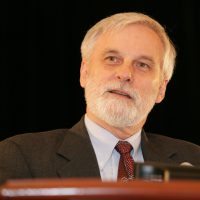It’s Time We Teach the Future As We Do the Past

by Guest Author Peter C. Bishop, Ph.D
We all have a future. We all worry, fear, dream about, and hold out hope for our futures. The future has fascinated people since the beginning of time, and it still does. Teachers claim to be preparing their students for the future. Christa McAuliffe, teacher-astronaut on the ill-fated Space Shuttle Challenger, said, “I touch the future. I teach.” And while the future is a consistent and important theme throughout education, it is largely only an implied theme today.
The reality is that teachers and students rarely discuss the future in their classrooms. Curriculum planners and designers do not build it into their curricula. State agencies, regional accrediting associations and non-profits like the College Board, the Educational Testing Service and the Common Core do not include it in their standards. What is going on here? We want students to be prepared for the future, but we don’t tell them about that future? It’s like preparing someone for a job in another country, but not telling them which country they are going to!
Of course, you can’t really blame teachers. They were never taught about the future either, as students themselves or in their preparation to be a teacher. So how are they supposed to teach something that they were not taught and do not know.
How can we teach the future?
And how can you teach the future anyway? It hasn’t happened; it doesn’t exist, yet. We’re not used to teaching things that don’t exist, you may say. But what about literature and fiction? Well, yes, but that’s different. That’s fiction, not fact. Then what about history? We believe it did exist at one time, but it doesn’t any more. If we can teach about the past, why can’t we teach about the future?
One reason is that the past is relatively clear and definite. The people of the past left us things that we can study and so come to know their time—photographs, documents, buildings, even their bones. The people of the future haven’t even created those things, much less passed them on to us. So how are we supposed to know the future without the evidence?
This is where the study of the past and the study of the future differ. Most of us believe there was one present in the past and that there will be one present in the future when it occurs. We also believe we know a lot about that single present in the past, but can we know that single present in the future before it happens? The answer is, “no.” The future holds too much complexity and too much uncertainty to be able to tell us today exactly what the future will be, although many people still try. That is why most teachers are reluctant to even talk about the future.
So, what are we to teach if we can’t know that one future? We should teach that the future is not that one future, but many possible futures. The real future today is not one true future hiding among a bunch of imposters. No, the real future today is all of those “imposters.” Since they all could plausibly occur, given one or another chain of causes and effects, they are all the future today. The future is many, not one.
This blog is no place to elaborate the technicalities of knowing the future. Suffice it to say that teachers can still introduce the future right now by simply asking three basic questions in any class, at any level:
- What do you think is going to happen in the future? The answer will likely be the Expected Future, where we are headed, what will happen if nothing truly surprising happens.
- What might happen instead? The answer is a set of Alternative Futures, the result of surprising and unexpected developments and of using incorrect assumptions about what could occur.
- What do you want to see happen in the future? The answer is the Preferred Future, based on values and preferences, the intended result of our effort to influence the future.
The future is teachable
Until recently, I was director of the graduate program in Foresight at the University of Houston, a program I have been a part of for more than 30 years. For many years, it was the first free-standing graduate foresight degree in the world. Since then, the program has graduated more than 300 professional futurists, many of whom are helping businesses, non-profits, government groups and even individuals to more effectively anticipate and influence the future.
While I still plan to teach in the program, I retired from directing it in 2013. I am now pursuing a personal passion — to introduce futures thinking to students in classes and schools around the world. It is now time to teach all students about the future!
For that reason, I have established a community, a collaborative, a social movement even, to change education in one very important, but precise way. It is called Teach the Future. It is my belief that every course, every school, every system should be teaching the future routinely as they do the past.
We know how to do that. We have been doing it at the University of Houston and at a handful of other universities around the world for 40 years now, with some incredible results. It’s time we spread that teaching where it can do the most good, to the children of today and the near future.
Peter C. Bishop, Ph.D, University of the Houston; www.teachthefuture.org; peter@teachthefuture.org; Bishop is also president of Strategic Foresight and Development, a firm that offers training and facilitation in strategic foresight (long-term forecasting and planning).

